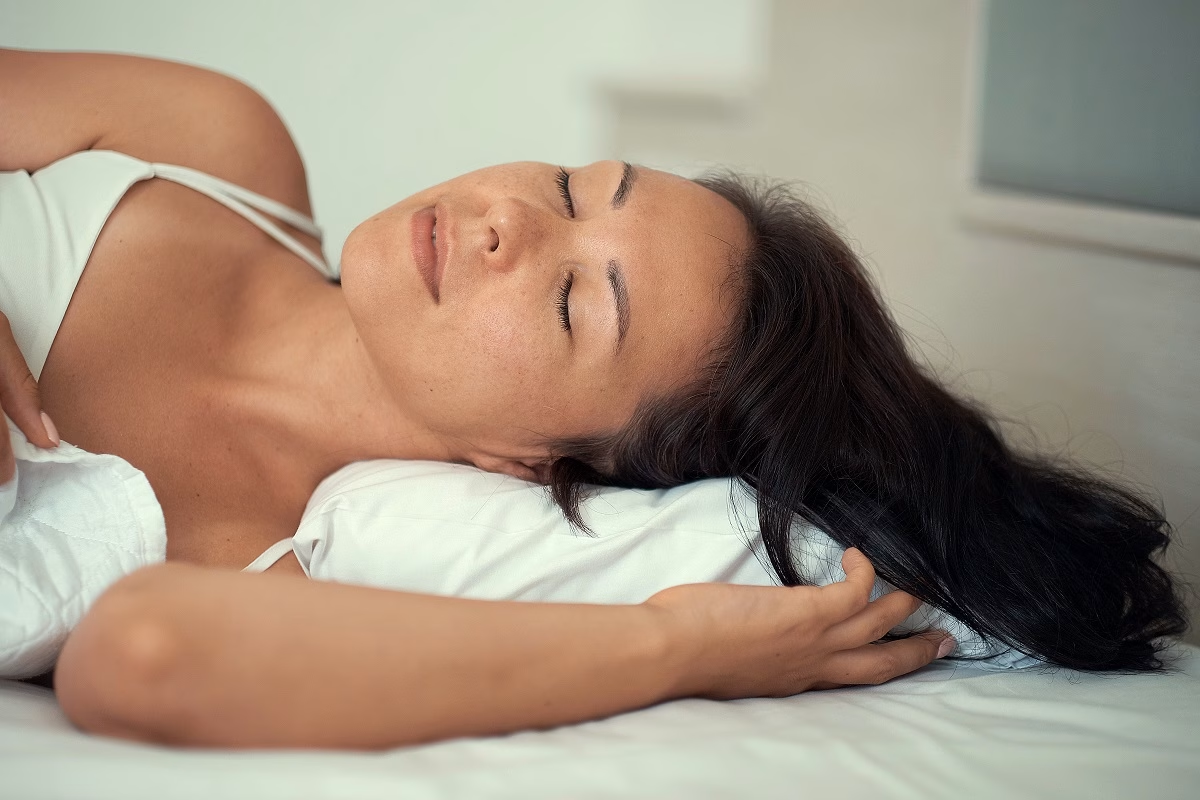A condition in which you physically act out of the dreams unknowingly while you are sleeping is called REM sleep behavior disorder (RBD). Movements that occur during sleep may cause injuries to the bed partner, especially if you are acting out a violent nightmare. If your partner suspects RBD, you should contact your healthcare professional right away.
In other words, REM sleep behavior disorder is a parasomnia, which is a sleep disorder that causes unusual and unwanted physical events or experiences that negatively affect the quality of sleep. Moreover, people with RBD tend to have more vivid dreams and have multiple REM cycles during the night. Usually, the first cycle starts about 90 minutes after you fall asleep and often lasts 10 minutes. However, further cycles may last longer.
In general, there are two types of RBD: isolated (idiopathic) and symptomatic (secondary). The idiopathic type of RBD occurs spontaneously without an underlying cause. In most cases, people with idiopathic RBD may also develop neurodegenerative disorders (also called alpha-synucleinopathies), including Parkinson’s disease, Lewy body dementia, or multiple system atrophy (MSA).
Secondary or symptomatic RBD occurs due to an underlying cause, such as type 1 narcolepsy. When a person develops both RBD and an alpha-synucleinopathy, it is considered a secondary type of the condition. Furthermore, in some cases, people who administer antidepressants may also develop RBD (drug-induced RBD).
This condition occurs quite rarely. It affects approximately 1% of the general U.S. population and about 2% of people over 50 years of age. However, rates of this condition can be higher in reality because RBD is difficult to diagnose, and most people do not even realize they have it.
Symptoms
The symptoms of people with RBD can vary in severity. Check below some symptoms that people with this condition usually experience:
- Mild muscle twitches
- Limb movements
- Talk, should, or scream (frequently using vulgar language)
- Jump or fall out of bed
- Punch, kick, or grab the air of their bed partner
- Sleep-related injuries (about 80% of people with RBD experience this symptom)
While an episode may occur once during a sleeping period, it may also happen multiple times. Usually, the symptoms are more severe when a person is acting out a violent nightmare. Furthermore, those who suffer from RBD are not aware of their behaviors during sleep. They often find out about RBD when their bed partner or roommate tells them about it, or wakes up with injuries.
In most cases, people with RBD wake up easily and can remember details of the dream. It is slightly different from night terrors when people have difficulty waking up and are confused. Sometimes, obstructive sleep apnea (OSA) may cause symptoms similar to RBD. In such cases, the condition is called pseudo-RBD.
Causes
In normal circumstances, almost all the body’s muscles (including skeletal muscles) are temporarily paralyzed during REM sleep to dream safely. This process is also known as muscle atonia. If you develop RBD, this temporary paralysis of the muscles does not occur. As a result, you may act out in your dreams and speak while sleeping. While experts do not fully understand why it happens, they think there is a combination of factors that eventually lead to RBD.
Idiopathic RBD Causes
According to some research, this type of RBD occurs due to a problem in a part of the brainstem (called the pons) that leads to REM sleep without atonia. These cells control muscle paralysis during REM sleep, and anything that damages them may lead to RBD. Damage to the pons is often associated with Parkinson’s disease, Lewy body dementia, or multiple system atrophy (MSA). In one study, healthcare providers identified that 97% of people with idiopathic RBD had one of the previous disorders within 14 years of their diagnosis.
Secondary RBD Causes
In most cases, people develop this type of RBD due to narcolepsy. It affects the production of Orexin (hypocretin), a specific brain chemical that regulates sleep, wakefulness, and appetite. Therefore, a lack of this chemical may fail to stabilize REM sleep, which triggers RBD.
Drug-induced RBD Causes
Researchers have noticed that people who take antidepressants may also develop RBD. It happens because of imbalances in certain neurotransmitters (such as Dopamine and Serotonin), which are involved in REM sleep.
Risk Factors
While anyone may develop RBD, some factors could elevate your risk of developing it. Check below some examples:
- Age – This disorder often affects people over 50 years old (the average age of onset is 61 years), but it may also affect children and younger adults.
- Sex – Males have a higher risk of developing RBD compared to females.
- Neurodegenerative disorders – There are some disorders that are often associated with RBD. For example, Parkinson’s disease, Lewy body dementia, and multiple system atrophy (MSA).
- Antidepressants
- Narcolepsy
- Misuse of alcoholic beverages
- Smoking
- Head injuries
- Continuous pesticide exposure
What Are The Potential Complications of REM Sleep Behavior Disorder?
People with RBD may also experience some complications. They often occur due to their uncontrollable movements during REM sleep. Check below some examples:
- Bruises
- Cuts
- Sprains
- Broken bones
- Head injury and subdural hematomas
In rare cases, these injuries can be life-threatening. In addition, roughly 90% of people with RBD have sleep issues, and about 60% of them have had physical injuries.
How to Prevent REM Sleep Behavior Disorder?
Unfortunately, in most cases, this condition cannot be prevented. However, you can take steps to manage factors that increase the risk of developing it. For example:
- Reduce stress
- Quit smoking
- Limit or avoid alcoholic drinks
- Manage narcolepsy or neurodegenerative disorders
For more details, discuss it with your doctor.
Diagnosis
If your bed or room partner tells you about RBD symptoms, immediately visit a doctor. Usually, the diagnosis begins with an evaluation of the medical history and questions about the symptoms. Doctors may also want to discuss with your bed or room partner to get more clues about the disease. They may also perform a physical and neurological examination.
This condition is often diagnosed during a polysomnography (PSG) or sleep study. These tests are often performed to check your heart rate, breathing rate, airflow, brain wave activity, eye movements, and muscle movements.
To confirm the diagnosis, you may have all of the following criteria. For example:
- Multiple episodes of sleep-related vocalization and complex movement behaviors.
- All behaviors are documented on a polysomnography and occur during REM sleep.
- You do not have atonia during REM sleep.
- Do not experience seizure-related activity during REM sleep.
- Your sleeping problems are not better explained by other health disorders (such as substance use disorder, obstructive sleep apnea, and others).
Treatment
The treatment goal is to reduce the symptoms and make a safe sleeping environment for you and your bed partner. Check below some treatments that doctors often recommend:
Medicines
When safe measures are not enough to prevent injuries, physicians may prescribe some medicines to ease the symptoms. In general, there are no FDA-approved medicines for RBD, and the following medicines are prescribed off-label. This process is legal because these medications do not cause severe adverse reactions or other serious health problems. They often recommend Melatonin, Clonazepam, and Pramipexole.
- Melatonin – This is a vital hormone produced by the pineal gland. It regulates the sleep cycle. Usually, it is considered the primary treatment for RBD as it rarely causes negative effects.
- Clonazepam – This is a sedative that effectively decreases the symptoms caused by RBD. Experts do not fully understand why it helps. Taking a small dose of Clonazepam often helps reduce the amount of nightmares, vocalizations, or dream enactment behaviors.
- Pramipexole – This medicine belongs to the Dopamine agonists and it is mainly used to treat Parkinson’s disease and restless legs syndrome. However, some recent studies have shown that it may also reduce the symptoms in people with RBD.
Safety Measures
- Take away glass, sharp, and heavy objects from the bed
- Place the pillows between you and surrounding structures (including a nightstand or headboard)
- You should also place the mattress on the floor next to the bed to prevent injuries if you fall out of bed
- You can also sleep in a sleeping bag
It is also recommended to sleep in another room if the symptoms are severe.
Frequently Asked Questions
Is REM sleep behavior disorder a mental illness?
RBD is not a mental disorder, such as mood or anxiety disorders. It is considered a sleep disorder (specifically a parasomnia).
What is the prognosis for REM sleep behavior disorder?
This condition significantly increases the risk of developing one of the neurodegenerative alpha-synucleinopathy disorders. Moreover, about 70% of people develop Parkinsonism or dementia within 12 years of their diagnosis.
Does RBD always lead to Parkinson’s disease?
While it does not always lead to Parkinson’s disease, RBD is a strong risk factor. There are a lot of people who have been diagnosed with Parkinson’s disease, Lewy body dementia, or multiple system atrophy (MSA) after RBD. Ask your healthcare provider if you have additional questions.




